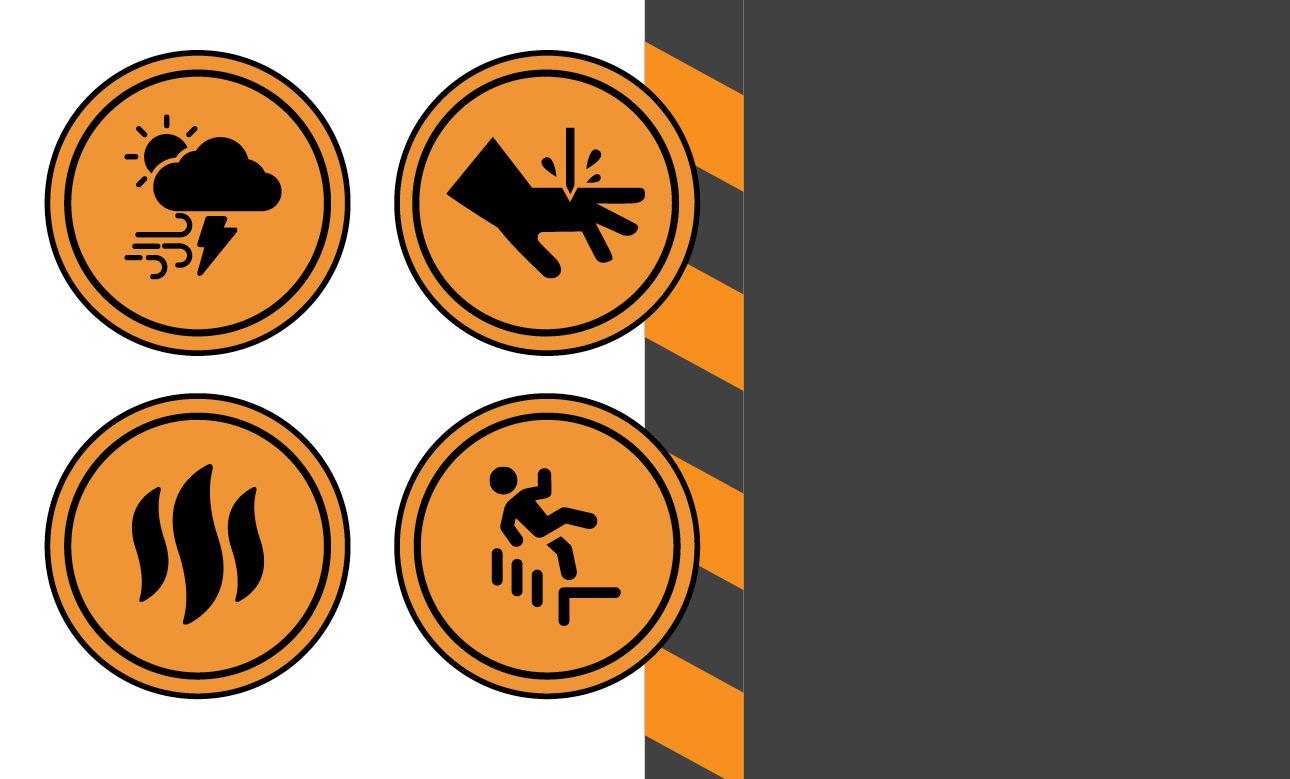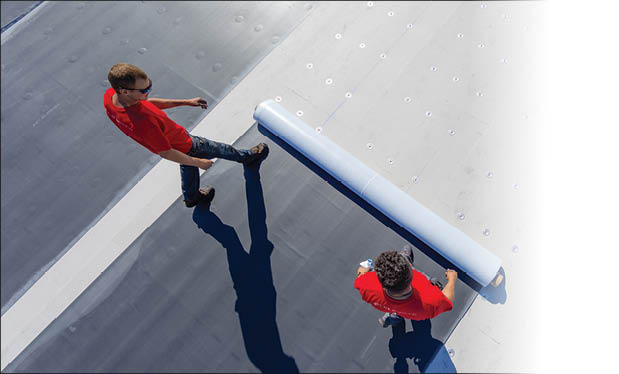
Like other types of construction projects, roofing jobs come with a significant degree of risk. Roofing workers suffer more nonfatal falls than those working in other professions, according to the Bureau of Labor Statistics, and they are 13 times more likely to suffer a fatal fall than workers in other professions.
When planning any roofing project, you should take time to assess potential risks and determine how to mitigate them. Completing a risk assessment is a smart way to anticipate possible problems so you can prevent them from happening. A risk assessment helps you have a plan in place for how to address those risks.
What is a risk assessment?
A risk assessment involves identifying potential threats or risks on a job site that are specific to a project. This includes roof slope, weak spots, electrical lines and other potential hazards. Once they are identified, each risk must be analyzed and evaluated to determine the potential likelihood of the risk occurring and its effect.
Goals of a risk assessment should include the following:
- Determining the parties that will be at risk and the risks they face
- Making people aware of the identified risks
- Assessing your current risk-prevention measures to determine whether they are adequate or whether you need to take further action
- Ensuring all contractual and legal requirements concerning risks are met
- Determining whether you need to implement additional controls or make changes to your risk strategy
- Ensuring workers are qualified and knowledgeable
- Determining which aspects, if any, of the roofing project can be done on the ground versus on the roof
- Assessing dangerous or problematic areas of the worksite
- Obtaining the necessary safety equipment
The following are some of the most common risk factors on roofing projects:
- Injury accidents caused by falls, strains and sprains, equipment malfunctions, dangerous chemicals or heat-related illness
- Equipment breakdowns leading to business interruptions
- Unexpected weather or environmental factors
- Labor shortages resulting in contract delays
- Damage to tools and supplies in transit
- Environmental liability caused by improper disposal
- Late-arriving supply shipments
- Late payments
Potential costs of not assessing risks
If you fail to assess and address risks on a roofing project, you could suffer the tragic loss of personnel. According to BLS, in 2021, there were 986 fatalities in the construction industry; 390 were from falls. Of the 986 fatalities, 123 occurred in the roofing industry; 99 of them from falls.
The Occupational Safety and Health Act contains a General Duty Clause that protects workers from “recognized hazards.” If employers don’t take reasonable measures to eliminate these recognized hazards, they can be cited. Failing to address and mitigate other risks—including supply chain problems and payment issues—could result in contract violations and business disruptions or closure.
Without a proper risk assessment, you also might overlook required equipment. For example, if roofing workers will be more than 6 feet off the ground, the Occupational Safety and Health Administration requires you to protect workers from falling. This may include installing guardrail systems or using personal fall-arrest systems. Any safety procedures you need to implement could require additional training, time and money. With a risk assessment, you’ll realize this at the start of a project, preventing you from going over budget and missing deadlines while properly protecting your workers.
Baseline assessment
To conduct a risk assessment, begin with a baseline assessment. A baseline assessment is used to establish an overall risk profile for a roofing project. It is used to obtain benchmarks of the types and sizes of potential risks. In a baseline assessment, you will need to identify the significant, major risks, prioritize them and evaluate the effectiveness of the current risk-control measures you have in place. You’ll systematically evaluate each part of a roofing job.
Workers should be top priority, and you should factor in other contractors and suppliers who may be on-site. The job site itself also needs a thorough review followed by equipment. What tools do you need for the job, and what risks could those pose? What tools do you need to mitigate risks? Other baseline areas to review include laws and permits, the environment and financial requirements.
The baseline assessment only provides a broad overview of a project’s risk profile. You will use it to perform subsequent risk assessments. A baseline assessment focuses on identifying risks that apply to the entire project or your company.
Issues-based assessment
After you complete a baseline assessment, complete an issues-based assessment. This is a detailed analysis of issue-specific risks that can be used to develop action plans. An issues-based assessment focuses on the operational activities and processes involved with a specific project. It should focus on identifying risks involved with specific tasks, activities or processes and provide clear recommendations to management about how to address them.
Continuous assessment
Continuous assessments are conducted on an ongoing basis to identify hazards so they can be addressed immediately. They also help identify significant risks and gather feedback for the baseline and issues-based assessments. Continuous assessments should be performed by supervisors daily using checklists, inspections and other tools.
Top safety precautions
Following are safety precautions you should use to mitigate risks.
Know your duties and train your employees
You need to know and understand OSHA’s safety guidelines for roofing contractors. You also must know and understand state-specific regulations that may affect the operations on a job site and ensure your workers are fully trained in all safety regulations and requirements.
Provide your workers with safety equipment, and make sure they are trained to always use it whenever they work. Knowledgeable supervisors should be on the premises at all times to ensure worker compliance with safety procedures.
Identify all risks
Conducting the previously discussed assessments will help you identify the risks of a roofing project, including safety, environmental, financial, productivity and contractual risks. It can be helpful to refer to data from past projects, including incident reports, to help you anticipate risks a project may involve and plan accordingly.
Once you identify a risk, describe it, provide a risk response strategy and notify the team members who are responsible for managing the risk. Then, prioritize the anticipated risks in terms of the chance each risk will occur and the potential effect on your business.
Implement controls
There are several techniques you can use to implement controls, including the following:
- Knowing the risk: A full job-site assessment gives you the information you need to respond to the environment as much as possible. This includes knowing the tools needed, roof slope, potential rooftop danger areas, necessary chemicals and typical weather conditions.
- Transferring the risk: You might be able to transfer the risk to another party by requiring a bond for contractors and purchasing liability insurance.
- Avoiding the risk: You might avoid some risks by changing the scope of your work or being selective in the projects you bid. You also can assess which aspects of the project, if any, can be completed on the ground.
- Mitigating the risk: You can create processes or plans to mitigate risks. For example, if you want to prevent workers from falling, you could provide safety harnesses, guardrail systems, scaffolding or use a combination of fall-protection systems. Similarly, if you want to prevent people from being struck by debris falling from a roof, you could install debris nets on the roof or secure the perimeter around the worksite to eliminate foot traffic. Educating workers also must be a priority. Each worker should be able to recognize unsafe conditions and be empowered to maintain safe conditions.
- Accepting the risk: Some risks can’t be avoided in roofing projects and must be accepted so you can remain on schedule and prevent other risks to your employees. For example, if severe weather happens, you may have to halt work on the project for a couple days to prevent added risks to worker safety. Although this could result in a project delay, it may be an acceptable risk in exchange for the reduction in risk to employees’ safety. It’s impossible to completely eliminate the risk of falling, even with the best possible safety procedures in place.
A safe plan
Assessing the risks of a roofing project is critical for keeping your workers safe and protecting your business. Although some risks can be mitigated or avoided, others must be accepted. Transferring risks to third parties can help reduce your company’s exposure. Make sure to complete risk assessments before accepting a roofing project and always follow safety regulations and laws.
ELEANOR BELL is a former outreach manager for Bryant Surety Bonds, Doylestown, Pa.


